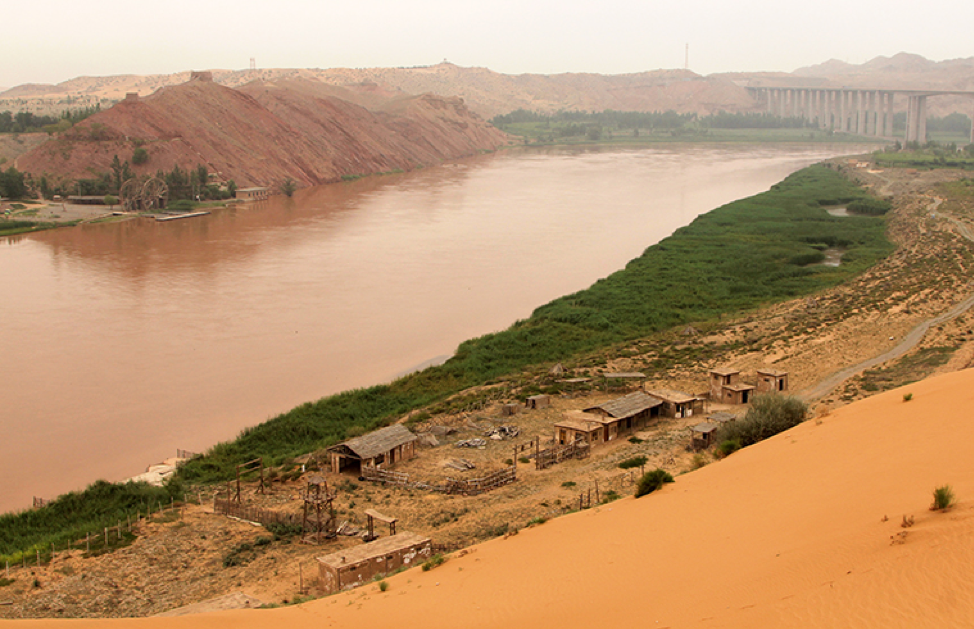Some 2,000 years ago, the Yellow River, swollen by flood waters and rain, broke its banks in North China. The event wiped out a massive number of people—probably millions—and resulted in “untold calamities,” says anthropologist Tristram R. Kidder.
Seeking to understand the root causes of the catastrophe, Kidder, the Edward S. and Tedi Macias Professor of Anthropology in Arts & Sciences, partnered with Liu Haiwang, senior researcher at China’s Henan Provincial Institute of Cultural Relics and Archaeology. The two embarked on a study that revealed how human action caused the flood and changed the environment in ancient China. They published the earliest known archaeological evidence for human construction of large-scale levees and other flood-control systems in China, arguing that ancient levees along the Yellow River in the flat, fertile Loess Plateau, set the stage for dynasty-toppling floods. The event, Kidder says, “changed the arc of history and reshaped the world that we inherited.”

By the time of Christ, with the expansion of Rome and the Parthians in ancient Iran, some populations became as great as the forces of nature, Kidder says. The Chinese, for example, began to build dams to control the river, altering the environment in the process. As they built the levees higher, the Yellow River became water poor and sediment rich. In the year 15—the time of China’s great flood—the ground measured 12 to 14 feet below the river bottom. Sanyangzhuang, a Han farming village buried by silt, left a nearly perfect preserved example of an ancient Chinese farming village, complete with tools, grinding stones, and the remains of looms. The treasure trove also revealed human footprints and evidence of silk leaves indicative of the area where the Silk Road began.
A remarkable civilization whose laws, technology, and culture provided the foundation for modern China today, the Han Dynasty (200 BC to 200 AD) had developed blast furnaces, mass production, and technology during its rule—innovations that would not appear in the West until 1400. To accommodate a burgeoning population, the government mandated an increase in growth and production, and the Han fought successive wars to expand their empire. Meanwhile, the climate became drier and drier. Fires erupted, pumping methane into the environment. More sediment reached the Yellow River, named so because huge amounts of the sandy soil turned the water yellow.
At the same time, the Han fought to prevail over nature. They destroyed trees and cleared land for farming and building. Nature had no time to reestablish itself. This dynamic makes China an exemplar of an Anthropocene world, explains Kidder. “Human activities have become so pervasive that they rival the forces of nature.”
While the research offers new insights into Chinese history, it also holds compelling implications for modern river management policies around the globe. “To think that we can avoid a similar catastrophe today due to better technology is a dangerous notion,” Kidder warns. “When in doubt, bet on Mother Nature because physics will win every time.”

To think that we can avoid a similar catastrophe today due to better technology is a dangerous notion…When in doubt, bet on Mother Nature because physics will win every time.
Tristram Kidder, Edward S. and Tedi Macias Professor of Anthropology
Like the Han, we are experiencing unprecedented climate change, Kidder says. “We need to plan and prepare and adapt accordingly. If we do not, we will be like the Han farmer 2000 years ago—stuck in the mud, unable to stop the rising water, scrambling to save family, friends, and himself.”
Social resilience to climate change
With this and other related research, Kidder has argued that early Chinese cities provide an important context that closely resembles modern cities, where high-density urbanism is supported by intensive agriculture. One study conducted with the Chinese Academy of Sciences in Beijing, shows that aridification in the central plains of China during the early Bronze Age did not cause population collapse, a result that highlights the importance of social resilience to climate change. The findings were published in Environmental Research Letters in May 2021.
“People in the past were able to overcome climate adversity because they were willing to change,” Kidder said.
During episodes of climatic aridification during this period, the Chinese expanded the number of plants they cultivated for food, innovated irrigation practices, and created new metal tools and new social structures to accommodate human adaptive ingenuity.
“We have remarkable capacity to adapt,” Kidder offered. “But part of the lesson here is that our social, political, and technological systems must be flexible.”
“We have remarkable capacity to adapt,” Kidder offered. “But part of the lesson here is that our social, political, and technological systems must be flexible.”
Tristram Kidder, Edward S. and Tedi Macias Professor of Anthropology
Kidder is fond of introducing new students to his research. For the past several years, he has co-taught “Earth’s Future: Causes and Consequences of Global Climate Change” with Brent Williams, who studies chemical properties of atmospheric and indoor gases and particles and serves as director of the Washington University Climate Change Program. Designed for first-year students, the popular course is interdisciplinary with expert lecturers from engineering, Arts & Sciences, architecture, public health, and social work sharing dive